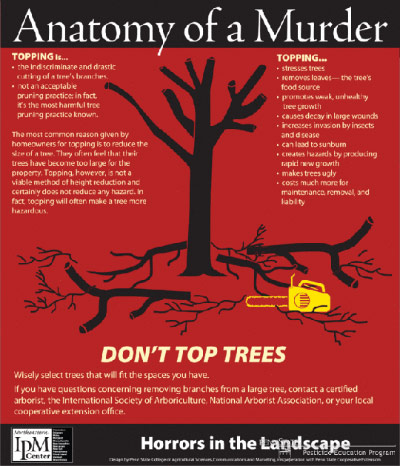IPM Hits Us Where We Live!
 |
|
Topping a tree can increase invasion by insects and disease. Posters like this will appear throughout the U.S. Botanic Garden next summer. |
Sustainable Lawns at the U.S. Botanic Garden
In summer 2008, more than 750,000 visitors will view a sustainable lawn care display at the U.S. Botanic Garden in Washington, DC, thanks to the Northeastern Community IPM Working Group. The display focuses on IPM-based lawn care practices and will be accompanied by “landscape bloopers” posters that illustrate common landscaping mistakes.
“This is a great opportunity to get the word out,” says Mary Kay Malinoski, University of Maryland Cooperative Extension, who co-leads the working group and is coordinating the project with members Rick Johnson, Penn State, and David Clement, University of Maryland. The display will run from Memorial Day through Columbus Day. The working group, supported by the Northeastern IPM Center, will also teach classes related to display content and interact with the public during several family days.
Practicing IPM at Home Protects Water Quality
In 2007, more than 100 professionals gathered near Philadelphia to explore connections between IPM and water quality in turf and structural settings. To build on the momentum of that event, the Northeastern IPM Center launched the Green-Blue Grants Program, which has disbursed more than $12,500 to promote clean water through residential IPM. Learn more about the Green-Blue Grants, which educate residents about how using IPM in residential structures and landscapes can affect water quality.
Reducing Health Risks for Public Housing Residents
Residents in urban settings are prone to pest problems and related housing conditions that threaten human health. The Northeastern IPM Center is providing solutions by leveraging resources to train and educate residents in low-income urban settings. The new training program responds to growing concerns about asthma, which afflicts more than 22 million Americans and can be triggered by cockroaches, mice, and the pesticides used to treat them.
The Center has hired Allison Taisey to coordinate this collaborative project, which involves CSREES, the U.S. Department of Housing and Urban Development, the Environmental Protection Agency (EPA), land-grant universities, and private consultants. Maintenance staff and residents will learn how to practice IPM successfully and contribute positively to healthy homes. The training tools will include an educational package for residents, a Train-the-Trainer curriculum for maintenance supervisors, and delivery of this curriculum to sites nationwide via DVD and webcast. A built-in evaluation phase will allow project leaders to measure the resulting increase in IPM adoption and to adapt the training materials for widespread use.
— by ELIZABETH MYERS
The Northeastern IPM Center promotes integrated pest management for reducing risks to human health and the environment. If republishing our news, please acknowledge the source (“From Northeast IPM Insights”) along with a link to our website.
